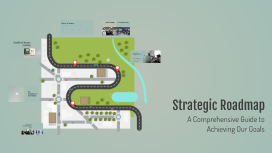Strategic Roadmap
Transcript: Components of the Roadmap Effective Implementation Strategies Best Practices for Execution Adhering to best practices for execution is crucial for a successful roadmap implementation. This includes defining clear roles, maintaining alignment to objectives, and ensuring resource availability to avoid roadblocks in achieving milestones. Monitoring Progress Adapting to Challenges Regular monitoring of progress using key performance indicators (KPIs) allows for timely adjustments in the roadmap. Tools such as dashboards and progress reports facilitate transparency and help identify areas needing focus or course correction. Flexibility is essential in adapting to challenges that may arise during implementation. Techniques such as scenario planning and stakeholder feedback can aid in making informed decisions and adjusting strategies accordingly to stay on track. Milestones and Timelines Communication Plans Effective communication plans are fundamental in maintaining stakeholder engagement throughout the roadmap's implementation. Consistent updates, clear messaging, and open channels for feedback help in aligning expectations and fostering collaboration. Goals and Objectives Milestones mark significant points in the project timeline, helping to track progress and maintain momentum. Establishing clear timelines for these milestones allows teams to prioritize tasks and allocate resources efficiently. Clearly defined goals and objectives serve as the foundation of any roadmap, guiding the strategy and actions needed for success. They should be Specific, Measurable, Achievable, Relevant, and Time-bound (SMART) to ensure effective planning and tracking. Strategic Roadmap Stakeholders Involved Resources Required Identifying the necessary resources—including personnel, budget, and technology—is critical for successful roadmap implementation. Ensuring these resources are available helps prevent project delays and enhances overall effectiveness. Engaging the right stakeholders is crucial for the success of the roadmap. Their insights, buy-in, and ongoing collaboration help shape the direction and execution of the project, fostering accountability and ownership. Introduction to the Roadmap Navigating the Path to Success Definition of a Roadmap Objectives of the Presentation A roadmap is a visual representation that outlines the strategic direction, key milestones, and objectives of a project or initiative. It serves as a blueprint for tracking progress and aligning stakeholders throughout the journey. The objectives of this presentation include establishing a common understanding of the roadmap's components, articulating its significance, and providing actionable insights for effective implementation. Importance of a Roadmap A roadmap is critical for ensuring all stakeholders are aligned towards common goals. It helps prioritize tasks, allocate resources efficiently, and enhances communication among team members. Overview of Key Components Key components of a roadmap include vision statements, strategic goals, timeline milestones, resource allocation, and responsibilities. These elements ensure a comprehensive approach to project management. Conclusion and Next Steps Future Considerations Summary of Key Points Ongoing evaluation of the roadmap is essential for adapting to changing circumstances and stakeholder feedback. Continuous stakeholder involvement and adapting strategies based on results enhance project resilience and effectiveness. The roadmap encompasses defined goals, milestones, stakeholder roles, and necessary resources. It serves as a crucial reference for aligning the team and tracking progress, ensuring all aspects of the project are covered effectively. Q&A Session Call to Action A designated question and answer session allows stakeholders to express concerns, seek clarification, and provide input on the roadmap. Engaging with the audience fosters transparency and collaboration, enhancing the overall effectiveness. Encouraging all team members and stakeholders to actively participate in the roadmap implementation is vital. Their insights and commitment will drive success, with regular updates and feedback loops ensuring everyone is aligned.

















